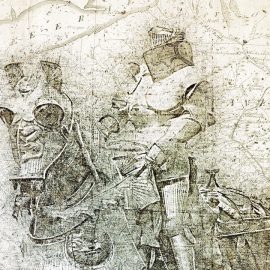

This article is an excerpt from the Shortform book guide to "American Prometheus" by Kai Bird and Martin Sherwin. Shortform has the world's best summaries and analyses of books you should be reading.
Like this article? Sign up for a free trial here.
Why did the Atomic Energy Commission want to revoke J. Robert Oppenheimer’s security clearance? How did the drama unfold, and how did it end?
J. Robert Oppenheimer was a scientist. But, he had political enemies who, time and time again, raised concerns over his apparent ties with—and leanings toward—communism. This all came to a head in 1953 when his security clearance, and therefore his career, came under threat.
Continue reading to learn about Oppenheimer’s security clearance hearing.
The 1954 Security Clearance Hearing
Though Oppenheimer had spearheaded the creation of the atomic bomb and served on various committees consulting the government on nuclear policy, he was often targeted by his political enemies after the atomic bomb for his past connections to communism. According to Bird and Sherwin, the animosity toward Oppenheimer culminated in December 1953, when he learned that the Atomic Energy Commission (AEC) intended to revoke his security clearance.
Biographers Kai Bird and Martin Sherwin write that the movement to revoke Oppenheimer’s security clearance was led by Lewis Strauss—the chairman of the AEC. Bird and Sherwin contend that Strauss’s disdain of Oppenheimer was deep-seated; in his 1949 testimony before the Joint Committee on Atomic Energy, Oppenheimer had embarrassed Strauss by sharply refuting Strauss’s testimony about the importance of isotopes in developing nuclear weapons.
(Shortform note: Though historians generally agree that Strauss was responsible for the AEC’s case against Oppenheimer, Harold Green—one of the AEC’s legal advisers in 1954, who resigned because the AEC mishandled the Oppenheimer hearing—claims that the case didn’t occur because of Strauss’s personal vendetta alone. Rather, he argues that Eisenhower’s 1953 directive, which ordered the AEC to place a “blank wall” between Oppenheimer and confidential information, spurred on the hearing. Strauss, he claims, would have likely preferred a subtler attempt to discredit Oppenheimer, rather than such a blatantly prejudiced hearing.)
After many confrontations with Oppenheimer about nuclear policy in the early 1950s, Strauss began plotting to get Oppenheimer’s security clearance revoked. According to Bird and Sherwin, he first contacted William Borden, the AEC’s staff director who felt similarly about Oppenheimer and provided Borden access to Oppenheimer’s security file. On the basis of this file, Strauss helped Borden compose a brief alleging Oppenheimer was likely a Soviet agent. Bird and Sherwin say that this brief led to an FBI report that convinced the Eisenhower administration to conduct an AEC hearing to revoke Oppenheimer’s security clearance.
(Shortform note: Borden’s legacy was permanently marred by his role in instigating the Oppenheimer hearing—according to President Kennedy’s national security adviser, McGeorge Bundy, Borden was even prevented from joining the Kennedy administration because of his defamatory letter against Oppenheimer.)
Strauss’s Illicit Tactics Throughout the Hearing
As the AEC’s chairman, Strauss had the authority to decide the three members of the AEC panel that would judge Oppenheimer. In addition to this authority, Bird and Sherwin argue, Strauss consistently employed illicit tactics throughout the hearing to predetermine the verdict against Oppenheimer.
Tactic #1: Biasing the Board
First, Bird and Sherwin point out that even before the hearing, Strauss actively biased the panel against Oppenheimer. They write that Strauss arranged for the panel members to read Oppenheimer’s FBI security file before the hearing—in the presence of prosecuting attorney Roger Robb, at that. Without Oppenheimer’s defense present, Robb personally guided the board through the most damning portions of Oppenheimer’s security file. As Bird and Sherwin relate, this violated the basic legal principle of tabula rasa—that juries approach trials with a clean slate and no preconceived opinions of the defendant.
(Shortform note: In the US, the notion of tabula rasa often figures heavily into applications of the Sixth Amendment, which guarantees defendants in criminal trials the right to trial by an “impartial jury.” For example, in the 1965 case Turner v. Louisiana, the US Supreme Court ruled that verdicts in criminal trials must be based exclusively on evidence presented in the trial rather than on the jury’s preconceived beliefs about the defendant. However, because Oppenheimer’s case was a security hearing, not a criminal trial, the requirement of tabula rasa didn’t apply.)
Tactic #2: Handicapping Oppenheimer’s Lawyers
Further, Bird and Sherwin observe that Strauss handicapped Oppenheimer’s lawyers by denying them a security clearance while providing one for the prosecuting lawyers. As a result, Oppenheimer’s lawyers often lacked access to the evidence presented to the panel, making it impossible for them to respond to the prosecution’s accusations.
(Shortform note: This hampering of Oppenheimer’s lawyers would not have occurred in a US criminal or civil case, in which all lawyers have the right to discovery—the process by which the prosecution and defense must exchange all evidence they intend to present, to avoid ambushes in the courtroom and provide ample time to assess the evidence.)
Tactic #3: Illegal FBI Wiretaps
Finally, Bird and Sherwin write that Strauss had access to illegal FBI wiretaps of Oppenheimer’s conversations with his lawyers. As a result, Strauss could predict the defense lawyers’ legal tactics and relay them to Robb, the prosecuting attorney. These illegal wiretaps not only violated attorney-client privilege but also provided Robb with a strategic edge throughout the hearing.
(Shortform note: FBI Director J. Edgar Hoover, who authorized the illegal wiretaps on Oppenheimer, was often suspected of illegally obtaining information about Americans he thought had communist associations. Notoriously, because he believed the Civil Rights Movement was infiltrated by communists, Hoover authorized illegal wiretaps of Martin Luther King Jr.’s home until 1965, and he also wiretapped the home of King’s lawyer, Stanley David Levison.)
The Presentation of the Chevalier Incident
Bird and Sherwin contend that, in addition to underhanded tricks, the prosecution relied heavily on Oppenheimer’s testimony about the “Chevalier incident,” a conversation between Oppenheimer and Haakon Chevalier, his close friend and fellow Berkeley faculty member, in late 1942.
Months later, in August 1943, Oppenheimer first gave an account of this conversation to Colonel Boris Pash. Oppenheimer told Pash that he and two other scientists had been approached by an intermediary (later revealed as Chevalier) who was friends with George Eltenton, a physicist with connections to the Soviet Union. Per Oppenheimer’s testimony, this intermediary told Oppenheimer and the other scientists that Eltenton hoped to relay information about the Manhattan Project to the Soviets, a suggestion Oppenheimer immediately called treasonous.
Later, in June 1946, FBI agents simultaneously interviewed Eltenton and Chevalier about Chevalier’s discussion with Oppenheimer in 1943, giving them no time to coordinate their answers. They both corroborated Oppenheimer’s previous account, with one glaring exception: They both denied having approached two other scientists, as Oppenheimer claimed. Later, in September 1946, FBI agents interviewed Oppenheimer himself, who admitted to fabricating elements of his original account to protect Chevalier’s identity.
Bird and Sherwin point out that, in the 1954 hearing, Oppenheimer’s prior false testimony proved damning. Robb compelled Oppenheimer to admit to the AEC’s panel that he had lied to the FBI and waited eight months to disclose a conversation of crucial security information. Moreover, in the heat of the examination, Robb induced Oppenheimer to call himself “an idiot” who told “a whole fabrication and tissue of lies.” This testimony, Bird and Sherwin argue, greatly discredited Oppenheimer in the eyes of the panel.
The AEC Panel’s Ruling
Strauss’s efforts to revoke Oppenheimer’s security clearance proved successful in May 1954: The panel voted two to one to revoke Oppenheimer’s security clearance, deeming Oppenheimer a security risk (though affirming his loyalty to the US). Bird and Sherwin argue that the dissent, written by Ward Evans, captured the true nature of the hearing: It pointed out that nearly all the evidence in the hearing was known in 1947 when Oppenheimer’s security clearance was renewed by the AEC. For this reason, Evans thought there was no justification for revoking Oppenheimer’s clearance years later. And, although the ruling was technically a recommendation, Bird and Sherwin note that it was ratified by AEC commissioners in a four-to-one vote in June 1954.
(Shortform note: The panel’s two-to-one ruling represents another key difference between the AEC’s security hearings and US criminal trials, which require juries to deliver a unanimous verdict. Similarly, civil trials normally require unanimous verdicts, though exceptions exist when the prosecution and the defense agree to allow nonunanimous verdicts. So, by permitting nonunanimous rulings, the AEC’s hearing made it easier to rule against Oppenheimer.)
Bird and Sherwin contend that the loss of Oppenheimer’s security clearance signified his fall from grace in the eyes of politicians and much of the American public. They argue that Oppenheimer effectively underwent a transformation after the security hearing: He was no longer an inside adviser on nuclear policy but instead an exiled intellectual.

———End of Preview———
Like what you just read? Read the rest of the world's best book summary and analysis of Kai Bird and Martin Sherwin's "American Prometheus" at Shortform.
Here's what you'll find in our full American Prometheus summary:
- The biography of J. Robert Oppenheimer that inspired the movie Oppenheimer
- Oppenheimer's early life and mental health struggles
- Oppenheimer's role in developing the atomic bomb and the following hearing






